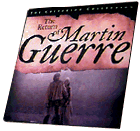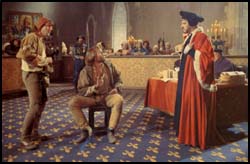

France drama
1982
color 123 min.
Director: Daniel Vigne
CLV: $69.95 - available
2 discs, catalog # CC1467L
 From the first mesmerizing sounds of Michel Portal's score--a blend of the archaic and the modern--The Return of Martin Guerre creates its own timeless universe. Daniel Vigne's film of 1982 is neither the first nor the last recounting of the love story and trial that took place in the mid-1500s. It followed a play, two novels, an operetta, and engendered a historical account, Sommersby (a remake with Jodie Foster and Richard Gere), and a stage musical. Paradoxically as contemporary as it is medieval, The Return of Martin Guerre offers a compelling take on justice, revenge, and love.
From the first mesmerizing sounds of Michel Portal's score--a blend of the archaic and the modern--The Return of Martin Guerre creates its own timeless universe. Daniel Vigne's film of 1982 is neither the first nor the last recounting of the love story and trial that took place in the mid-1500s. It followed a play, two novels, an operetta, and engendered a historical account, Sommersby (a remake with Jodie Foster and Richard Gere), and a stage musical. Paradoxically as contemporary as it is medieval, The Return of Martin Guerre offers a compelling take on justice, revenge, and love.
It was shot in a French peasant village that has remained virtually unchanged since the 1550s; forty kilometers away was the actual town where a youth named Martin Guerre married Bertrande de Rols, disappeared for nine years, and returned to reclaim his wife and land.
A gripping drama of identity and fidelity is played out in the film version after villagers began to doubt whether Martin (Gerard Depardieu) is really the same man who left them in his youth. Despite evidence to the contrary, Bertrande (Nathalie Baye) insists that he is her husband.
The Return of Martin Guerre took shape when the renowned screenwriter Jean-Claude Carriere (whose collaborations include The Tin Drum, The Unbearable Lightness of Being, and Valmont) read Jean de Coras' Arrest mémorable. He brought it to the attention of Vigne, who had directed Countryside Inventory, a prize-winning television series.
Then another film artist with ties to the land entered the picture‹superstar Gerard Depardieu. "I couldn't have put those bangs and the cap he sometimes wears on just any actor," said Vigne. "Depardieu lends himself to that. And since the film is about a man who might be an inventive dreamer‹a liar‹he's perfect: he loves to play!"
No less impressive is Nathalie Baye (Godard's Every Man For Himself, Truffaut's Day for Night, Swaim's La Balance) as Bertrande, who falls in love with a man who may or may not be her husband. Atypical for our assumptions about the Middle Ages, Martin Guerre suggests that a woman's sexual pleasure matters.
To capture the desired visual texture, Vigne took his cinematographer to the Louvre, where they studied the 16th- and 17th-century countrysides of Bruegel, van Ostade, and La Tour. He wanted one source of light within the frame, whether from a window, a candle, or a hearth.
If the images-including warm colors and golden light-suggest Flemish painting, Portal's original soundtrack invokes the 20th century. Its central instrument is the bandoneon, which gives Argentine tangos their sensual poignance. Layered with electronic music, the result won the French Academy Award for Best Score--and contributed to a haunting cinematic experience.
-- Annette Insdorf
Annette Insdorf, Professor of Film at Columbia University, is the author of François Truffaut and Indelible Shadows: Film and the Holocaust.




